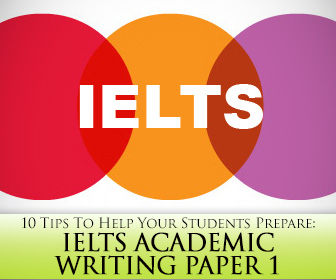
The IELTs Academic Writing Paper 1 is one that students often worry about.
The variety of graphs and tables used can be daunting and having the right vocabulary to give a clear and concise explanation can seem like a mountain to climb. These 10 tips should help you give your students the basics that will make the task more achievable.

Contribute to the Students’ Success in IELTS Academic Writing
-
1
Familiarization Is the Key
There are a variety of different formats that could come up in the test and as part of their preparation students should familiarize themselves with as many as possible so that they are then able to more easily read the information given. Bar graphs, line graphs, pie charts, flow charts, tables and diagrams; any of these could be used. It is also a good idea to check that your students know what the abbreviations are for the measurements used e.g. do they know that mph is miles per hour. Giving your students an overview of how to read these possibilities could stop them freezing when they are presented with the paper. They will better understand the information given if they are familiar with how it is presented.
-
2
Preparing the Right Vocabulary
Although the range of vocabulary is vast some more general language areas will help students to write a clear and concise answer. Equipping your students with the language of change, the language of cause and effect and the language of comparison and contrast will ensure they have the necessary language to address the task.
-
3
Identifying the Main Features
The introduction will give the main topic but students should quickly identify what the diagram is doing; is it contrasting information or showing change? They should look at the diagram labels. What units are used? Which years are listed? What are the headings?
-
4
Which Information Should Students Write About?
Students should be trained to look at the extremes and the similarities. What is the greatest contrast/change? Are there any categories that could be grouped together? What are the main trends? There can be a tendency for students to write about everything they see but with a word count of 150 words this task needs to be very focused.
-
5
What Is the Purpose of the Task?
Students need to be encouraged to focus on the information contained within the diagram not describe it. The objective may be to compare data or describe a process or how something works. Identifying the objective should be practised in class as it is critical to writing a good answer. This should be emphasised, as a long description of what they see will not earn them high marks.
-
6
Writing the Introduction
The introduction of the task will tell them what the graph says and this introduction should be paraphrased in their introduction not copied. Give students copies of a task and model answers for that task. Then ask them to identify the parallel words or phrases used. This will help them to think about how they will paraphrase their own introduction paragraphs.
-
7
Writing the Body of the Text
Ensure your students have a good grasp of linking words so that they can write clear and structured paragraphs. A good way to do this is to give them exercises with sentence openings which have to be put into a logical order.
-
8
Look at the Dates
Many of the graphs and diagrams will include dates. The dates will tell your students which tenses they will need to use in their answer.
-
9
Writing the Summary
This is not the place to explain the information but is where your students need to summarize the key points. Ask them to use clear signposting language to show that this is the summary ie ‘overall’, ’in brief’, ‘to sum up’.
-
q
Edit, Edit, Edit!
Students are only given twenty minutes to complete this task however they should give themselves a minute or two to edit for common mistakes. Most students on reading back will find the odd mistake and correcting them may earn them extra points.
Preparing students for Writing Task 1 is really a case of giving them the tools they need.
Follow these tips and they will enter the exam room with a better understanding of what is expected of them.
P.S. If you enjoyed this article, please help spread it by clicking one of those sharing buttons below. And if you are interested in more, you should follow our Facebook page where we share more about creative, non-boring ways to teach English.







